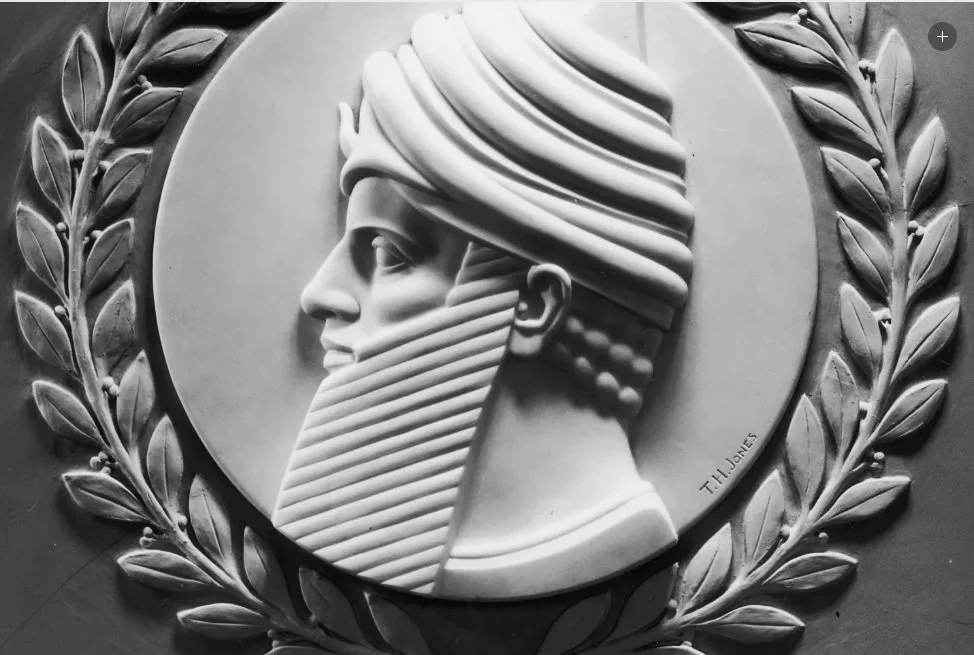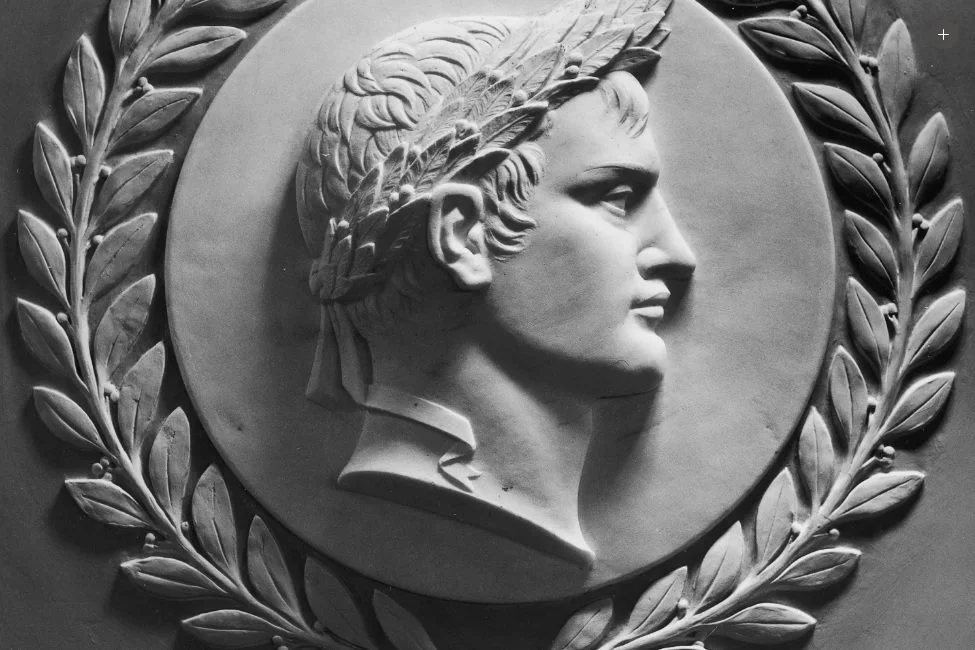Congress Honors 23 Historical Figures
Twenty-three marble relief portraits are displayed over the doors of the U.S. House of Representatives chamber. These reliefs depict historical figures noted for their work establishing principles that underlie American law. An organized society cannot exist without laws. The law defines individual rights, crimes, and punishments. Business laws define the rules for commerce. Property laws define ownership and how it can be changed. And laws provide methods for dispute handling.
The official Capital website states: "The subjects of the reliefs were chosen by scholars from the University of Pennsylvania and the Columbia Historical Society of Washington, D.C., in consultation with authoritative staff members of the Library of Congress. The selection was approved by a special committee of five Members of the House of Representatives and the Architect of the Capitol."
Who are these 23 men, and why were they selected?
Ancient Times
Hammurabi (Photo: Architect of the Capital (AOC)
Hammurabi, king of ancient Babylonia (in modern Iraq), is the earliest person represented in the 23 relief portraits. He is the author of the Code of Hammurabi, one of the earliest surviving legal codes. The code consists of 282 laws, including family law (marriage and divorce), criminal law (violence and theft), and civil law. The economic elements covered by these case laws include pricing, tariffs, trade, and commerce. These codes, written over 3,700 years ago, include many modern concepts. Women's rights are covered. One of the laws provides alimony and child support in case of divorce. Another clause relates to modern judicial procedure, both plaintiff and defendant may bring witnesses to testify. And defendants are innocent until proven guilty. The code provides for compensation proportionate to damages in negligence cases: "If anyone hires oxen and kills them by bad treatment or blows, he shall compensate the owner, oxen for oxen." One of the laws introduced the 'eye for an eye' idea: "If a man put out the eye of another man, his eye shall be put out."
After Hammurabi is Moses. Over 3,000 years ago, he received the body of Jewish law, most notably the Ten Commandments, which provide a moral basis for society.
The gallery doors include two Greek men. Lycurgus is credited with creating the laws of Sparta around 900 BC. And in the 6th century BC, Solon created the constitution establishing Athenian Democracy.
Roman and Byzantine Periods
Rome existed for over 1,500 years, from the Roman republic founding around 500 BC until the end of the Eastern Roman Empire (Byzantine) in 1,453 AD. Emperor Justinian I of the Byzantine empire published the Code of Justinian in 534 AD. This code reorganized and consolidated Roman law. He was assisted by jurist Tribonian who relied, in part, on earlier work performed by Romans Gaius and Papinian in the second and third centuries AD. The Justinian code included over 4,000 laws covering everything from crimes to family law to property law. It has many concepts underlying modern society.
One of its provisions is similar to our Bill of Rights:
"…whoever is charged with a capital crime shall not immediately be considered guilty, merely because he has been accused, in order that innocence may not be unjustly punished… so that whoever is charged with a capital crime shall not immediately be considered guilty, merely because he has been accused, in order that innocence may not be unjustly punished; but that the accuser shall appear in court, give the name of the defendant, make the accusation in writing…."
Middle Ages
The Congressional relief portraits include several figures from the medieval period. Pope Innocent III (Pope from 1198 – 1216) and Pope Gregory IX (1227 – 1241) are both credited with maintaining Roman law through the Dark Ages.
Maimonides (1138 – 1204) was a famous Jewish scholar born in Spain. He organized Jewish law covering the two thousand year span since Moses received the Ten Commandments at Mount Sinai. He also wrote 'The Guide for the Perplexed.' He attempted to reconcile science and faith. A famous quote for this guide is particularly relevant to today's concerns about fake news:
"Truth does not become more true by virtue of the fact that the entire world agrees with it, nor less so even if the whole world disagrees with it."
King Alfonso X (1221 – 1284) of Spain created a legal code known as the 'Seven Parts.' The code was wide-ranging, covering commercial transactions, family law, and criminal law. Spanish explorers brought the code to the New World, and portions remained in effect throughout Latin America well into the 1800s.
The Vatican canonized King Louis IX of France (1214-1270). Also known as Saint Louis, the reliefs credit his ability to arbitrate disputes.
Two medieval Englishmen are displayed in the gallery. Simon De Montfort (1200 – 1265) was a noble who opposed the autocratic rule of King Henry III. He led a rebellion that temporarily overthrew the monarch. De Montfort then expanded the composition of Parliament to include a broad representation of British society. His Parliament was an early forerunner of today's House of Commons.
King Edward I reigned from 1272 – 1307. As portrayed in the movie 'Braveheart,' he was also known as the 'Hammer of the Scots' for invading Scotland. In 1295, King Edward I called the 'Model Parliament' into session. He expanded its composition resulting in the broadest representation to that point in English history. One of the laws passed regarding free elections is still in effect today:
"because Elections ought to be free, the King commandeth upon great Forfeiture, that no Man by force of Arms, nor by Malice, or Menacing, shall disturb any to make free Election."
Early Modern Era
Suleiman (1494-1566), Sultan of the Ottoman Empire, reformed and improved civil and military codes while uniting the empire.
Hugo Grotius (1583-1645), a Dutch statesman, authored 'On the Law of War and Peace,' the first treatise on international law governing relations between nations.
Three Frenchmen are honored. Jean Baptiste Colbert (1619-1683), French finance minister under Louis XIV, codified various ordinances and reformed the French legal system. A French jurist, Robert Joseph Pothier (1699-1772), wrote several treatises on French law, which were incorporated into the French Civil Code.
Napoleon (Photo: AOC)
Napoleon (1769 – 1821): Including a military general in this group of men is a surprise. However, while Napoleon was busy conquering Europe, he also implemented a code of law known as the Napoleonic code. As with the other legal codes, this code covered a wide range of topics, including family law, criminal law, and commercial law. One of its most important provisions provided for freedom of religion. Later in life, Napoleon said about his code:
"My real glory is not the forty battles I won, for Waterloo's defeat will destroy the memory of as many victories.… What nothing will destroy, what will live forever, is my Civil Code."
Sir William Blackstone (1723-1780), an English jurist, authored the Commentaries on the Laws of England, which considerably influenced the adaptation of English common law in America. His book included the following statement, known as the 'Blackstone Ratio.'
"It is better that ten guilty persons escape than that one innocent suffer."
Modern Era
The last two reliefs are American Founding Fathers – George Mason (1725 – 1792) and Thomas Jefferson. (1743 – 1826). Mason drafted the Virginia Declaration of Rights in 1776, which influenced the Declaration of Independence. He also refused to sign the U.S. Constitution until the Bill of Rights was approved.
Jefferson wrote the famous words in the Declaration of Independence:
"We hold these truths to be self-evident, that all men are created equal, that they are endowed by their Creator with certain unalienable Rights, that among these are Life, Liberty and the pursuit of Happiness."
Jefferson also wrote the Statue of Virginia for Religious Freedom, a precursor to the U.S. Constitution's first amendment guarantee:
"Congress shall make no law respecting an establishment of religion, or prohibiting the free exercise thereof."
Conclusion
Modern law has been built on a foundation stretching back over 3,700 years. Congress has recognized these 23 men for their contributions through a series of marble reliefs. To view those reliefs, click here.

